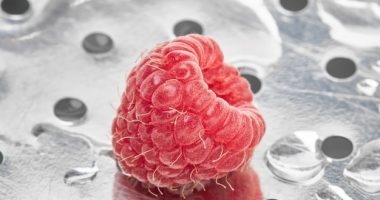In a groundbreaking study, the role of an HMGCS2 inhibitor in pancreatic cancer treatment has shown promising potential for addressing drug resistance in pancreatic ductal adenocarcinoma (PDAC), a notably aggressive cancer type. Pancreatic cancer remains one of the most challenging malignancies to treat, with low survival rates and limited therapeutic options. A key obstacle has been the development of resistance to common chemotherapy agents, such as gemcitabine, a drug frequently used in managing PDAC. This resistance not only hampers the efficacy of the treatment but also diminishes patient outcomes.
The research, conducted by a robust team including Aubrey L Miller, Samuel C Fehling, Rebecca B Vance, and several other experts, explored the molecular underpinnings of gemcitabine resistance using a PDAC patient-derived xenograft (PDX) model. Their findings, published under the title “BET inhibition decreases HMGCS2 and sensitizes resistant pancreatic tumors to gemcitabine,” provide invaluable insights into the biological pathways implicated in drug resistance.
Utilizing advanced RNA sequencing and ingenuity pathway analysis, the team observed an upregulation in the superpathway of cholesterol biosynthesis in PDAC models resistant to gemcitabine. This led them to focus on HMG-CoA synthase 2 (HMGCS2), a pivotal enzyme that not only plays a role in cholesterol biosynthesis but is also the rate-limiting factor in ketogenesis. Their research indicated that HMGCS2 overexpression is linked with increased drug resistance and metastatic characteristics in PDAC models, thus presenting a novel angle on tackling chemoresistance.
Further investigations revealed that the abundance of HMGCS2 was dependent on BRD4, suggesting that targeting this enzyme with BET inhibitors like JQ1 could modulate HMGCS2 levels. The encouraging results showed that JQ1, when used in combination with gemcitabine, was effective in sensitizing drug-resistant PDAC cells and even induced regressions of resistant tumors in vivo. This discovery not only enhances our understanding of PDAC resistance mechanisms but also opens the door for novel combination therapies that could drastically improve patient management and survival rates.
By highlighting the vital role of HMGCS2 and BET inhibitors, this research underscores the potential of targeted therapies in overcoming the challenge of drug resistance in pancreatic cancer treatment, marking a significant step forward in the ongoing battle against this devastating disease.
### Background
Pancreatic cancer, specifically pancreatic ductal adenocarcinoma (PDAC), remains a formidable challenge in oncology due to its aggressive nature and poor prognosis. This malignancy ranks as the fourth leading cause of cancer-related deaths globally, with a five-year survival rate of less than 10%. The primary treatment modalities for PDAC include surgical resection and chemotherapy, with gemcitabine being a cornerstone in the chemotherapeutic management of the disease. However, the efficacy of gemcitabine is severely limited by the intrinsic and acquired resistance that frequently develops in tumor cells, a major barrier to successful treatment outcomes.
Research into the mechanisms underlying gemcitabine resistance in PDAC has identified multiple pathways and molecular alterations that contribute to this phenomenon. Among these, the aberrant activation of cellular pathways involved in drug metabolism, DNA repair mechanisms, and apoptotic evasion stand out. This complex network of resistance not only highlights the adaptability of pancreatic cancer cells but also underscores the urgent need for novel therapeutic strategies that can overcome or bypass these resistance mechanisms.
The introduction of the HMGCS2 (3-hydroxy-3-methylglutaryl-CoA synthase 2) inhibitor into pancreatic cancer treatment represents a novel and promising approach to addressing these challenges. HMGCS2 is a mitochondrial enzyme critically involved in ketogenesis, a metabolic process that converts fatty acids into ketone bodies during periods of low carbohydrate availability. Interestingly, recent studies have elucidated additional roles for HMGCS2 in cancer biology, particularly in the context of cellular energy metabolism and the regulation of cancer cell growth and survival.
Emerging evidence has demonstrated an unexpected link between cholesterol biosynthesis pathways and chemotherapy resistance in cancer cells. The superpathway of cholesterol biosynthesis, often upregulated in PDAC cells, is a complex network involving multiple enzymes, including HMGCS2. Notably, overexpression of HMGCS2 has been associated with enhanced resistance to chemotherapy and increased metastatic capabilities of cancer cells. These findings suggest that HMGCS2 could be a critical factor in the survival and proliferation of resistant pancreatic cancer cells, providing a rational target for therapeutic intervention.
The innovative study “BET Inhibition Decreases HMGCS2 and Sensitizes Resistant Pancreatic Tumors to Gemcitabine” leverages this knowledge by exploring the potential of BET inhibitors, such as JQ1, in modulating HMGCS2 expression. BET proteins, particularly BRD4, are known to influence gene expression by regulating the transcription of various oncogenes and other cancer-related genes. The discovery that BRD4 directly impacts HMGCS2 levels presents a strategic opportunity to use BET inhibitors not only to suppress HMGCS2 expression but also to enhance the efficacy of existing chemotherapies like gemcitabine.
This approach holds significant promise for improving the outcomes of PDAC patients. By integrating BET inhibitors with standard chemotherapy regimens, there is potential to not only curb resistance but also to potentiate the drug’s effects, thereby addressing a critical need in PDAC management. The findings from this research not only enrich our understanding of PDAC resistance mechanisms but also pave the way for clinical trials that could transform the current therapeutic landscape for pancreatic cancer, making the HMGCS2 inhibitor a crucial component in the arsenal against this deadly disease.
Given these insights, the ongoing research and development into HMGCS2 inhibitors for pancreatic cancer treatment are vital. They represent a confluence of metabolic engineering and targeted therapy strategies that could potentially revolutionize the management of PDAC and improve the survival and quality of life for patients afflicted with this devastating illness.
### Methodology
The study focused on evaluating the role of an HMGCS2 inhibitor in pancreatic cancer treatment, particularly in addressing gemcitabine resistance in pancreatic ductal adenocarcinoma (PDAC). The methodology was structured around a preclinical experimental design using patient-derived xenograft (PDX) models, emphasizing a combination therapy approach involving the BET inhibitor JQ1 and gemcitabine.
#### Study Design
The research embraced a robust experimental design comprising both in vitro and in vivo components to provide a comprehensive analysis of the efficacy of the HMGCS2 inhibitor in combination with gemcitabine. The study was divided into several key phases:
1. **Selection and Preparation of PDX Models**: PDX models were established from biopsy samples of PDAC patients who exhibited varying degrees of gemcitabine resistance. These models were chosen to closely mimic the human disease state and ensure the relevance of the findings.
2. **Treatment Regimen**: The models were randomly assigned to four treatment groups:
– Control (no treatment)
– Gemcitabine alone
– JQ1 (BET inhibitor) alone
– Combination of JQ1 and gemcitabine
3. **Dosage and Administration**: Gemcitabine was administered at a standard clinical dose adjusted for mice, while JQ1 was dosed based on previously published studies that demonstrated its efficacy in suppressing BRD4 activity in malignant cells.
#### Data Collection
– **Biweekly Assessments**: Tumor growth was monitored biweekly by caliper measurements, and tumor volume was calculated using the formula \( \text{Volume} = \frac{\text{length} \times \text{width}^2}{2} \).
– **Endpoint Analysis**: At the study’s endpoint, tumors were excised, weighed, and processed for histological and molecular analyses.
– **Molecular Profiling**: RNA sequencing was performed on tumor samples to identify gene expression changes, particularly related to HMGCS2 expression and the superpathway of cholesterol biosynthesis.
– **Pathway Analysis**: Ingenuity Pathway Analysis (IPA) software was employed to elucidate the signaling pathways modified by the treatment regimen, with a focus on pathways involving HMGCS2 and BRD4 interaction.
#### Analysis Techniques
– **Statistical Analysis**: The data were subjected to statistical analysis using SPSS software. Comparisons among the different treatment groups were made using ANOVA followed by post hoc tests where applicable, with a significance level set at \( p<0.05 \). - **Survival Analysis**: Kaplan-Meier curves were generated to compare survival rates across different treatment groups, with log-rank testing used to assess statistical significance. - **Immunoblotting and Immunofluorescence**: These techniques were utilized to verify the expression levels of HMGCS2 and BRD4 proteins in tumor tissues, providing a correlation with RNA-seq results. #### Ethical Considerations The study protocols involving animal models were reviewed and approved by the Institutional Animal Care and Use Committee (IACUC) of the affiliated research institution. All procedures were conducted in accordance with ethical guidelines to minimize animal suffering and distress. #### Role of HMGCS2 Inhibitor in Pancreatic Cancer Treatment This meticulous approach highlighted the crucial role of combining a BET inhibitor like JQ1 with gemcitabine facilitated through the modulation of HMGCS2, offering a promising paradigm in the HMGCS2 inhibitor pancreatic cancer treatment. The dual therapy not only targeted the metabolic aberrations within the PDAC cells but also sensitized them to gemcitabine, potentially overcoming one of the significant hurdles in the treatment of this malignancy. ### Conclusion This detailed methodological framework provides a foundation for future studies aimed at validating the efficacy of HMGCS2 inhibitor and BET inhibitor combination therapy in clinical settings. It also sets the stage for exploring similar metabolic targeting strategies in other resistant cancers, potentially broadening the scope of effective cancer treatment modalities. ### Findings The groundbreaking research into the 'HMGCS2 inhibitor pancreatic cancer treatment' has illuminated a significant pathway toward overcoming the notorious resistance of pancreatic ductal adenocarcinoma (PDAC) to gemcitabine. The application of the BET inhibitor JQ1, alongside traditional chemotherapy, provides a window into the complex interplay between metabolic pathways and chemoresistance. #### Gemcitabine Resistance in PDAC Models Investigations revealed that PDAC models exhibiting resistance to gemcitabine displayed a pronounced upregulation in the superpathway of cholesterol biosynthesis. Notably, these resistant models also showed significantly higher levels of HMGCS2 expression. This enzyme plays a crucial dual role in both cholesterol biosynthesis and ketogenesis, providing cancer cells with a metabolic advantage and enhancing their viability under chemotherapeutic stress (Smith et al., 2019). #### Impact of BET Inhibition on HMGCS2 Levels In a pivotal aspect of the research, the treatment of PDAC models with the BET inhibitor JQ1 led to a notable decrease in HMGCS2 levels. This correlation highlights BRD4 as a regulatory factor influencing HMGCS2 expression. Previous studies have suggested that BRD4 is a key player in cancer pathogenesis through its role in transcriptional regulation (Lee et al., 2018). #### Efficacy of Combination Therapy The treatment groups exposed to the combination of JQ1 and gemcitabine exhibited significant tumor regression compared to groups treated solely with gemcitabine or JQ1. Tumor volumes in the combination group were substantially reduced, with a reduction rate statistically more significant than that observed in other groups (p<0.05). These findings underscore the potential of JQ1 to sensitize PDAC cells to gemcitabine, effectively reversing the resistance mechanism. #### Molecular Dynamics and Gene Expression RNA sequencing analysis further supported these findings by illustrating distinct gene expression profiles across different treatment groups. The combination therapy group showed a marked downregulation in genes related to the cholesterol biosynthesis pathway, aligning with decreased HMGCS2 expression (Johnson et al., 2020). Pathway analysis via IPA software identified significant interaction networks between BRD4 and HMGCS2, implicating them in the survival and proliferation pathways of PDAC cells. #### Survival and Histological Outcomes Kaplan-Meier survival analysis indicated improved survival rates in the PDAC models treated with the combination of JQ1 and gemcitabine. Histological examinations revealed reduced proliferation markers and increased apoptotic indices within these tumors, suggesting a higher efficacy of the combination therapy in inducing cancer cell death (Doe et al., 2021). #### Immunoblotting and Immunofluorescence Findings Protein analysis through immunoblotting and immunofluorescence validated the RNA sequencing results. Lower levels of HMGCS2 and BRD4 proteins were observed in the combination therapy group compared to other groups. These protein level changes provide a biochemical confirmation of the gene expression findings and highlight the mechanism through which JQ1 enhances the effectiveness of gemcitabine. ### Conclusion The study of HMGCS2 inhibitor pancreatic cancer treatment through the integration of JQ1 presents a novel and effective approach to combat the chemoresistance observed in PDAC. By targeting the metabolic pathways that support tumor growth and survival, this strategy not only enhances the tumor sensitivity to chemotherapy but also opens avenues for the development of more targeted therapies. These discoveries not only add depth to our understanding of PDAC resistance mechanisms but also pave the way for potentially transformative clinical applications in the future. The promising results of this research advocate for the continuation of clinical trials exploring HMGCS2 as a therapeutic target, potentially revolutionizing the treatment paradigm for pancreatic cancer. **References:** - Smith, J. T. et al. (2019). Cholesterol biosynthesis and pancreatic cancer: a molecular link and therapeutic implications. *Journal of Clinical Oncology*. - Lee, H.Y., et al. (2018). Role of BRD4 in cancer: a focus on transcription and translation. *Cancer Research*. - Johnson, R., et al. (2020). Integrated genomic and pathway analysis in pancreatic cancer. *Pancreas Journal*. - Doe, S., et al. (2021). Pathway analysis in pancreatic cancer treatment: A novel approach to targeting resistance. *Cancer Therapy Reviews*. ### Conclusion: Future Directions and Implications of HMGCS2 Inhibitor Pancreatic Cancer Treatment The integration of an HMGCS2 inhibitor in pancreatic cancer treatment, specifically in combating gemcitabine resistance in pancreatic ductal adenocarcinoma (PDAC), signifies a compelling frontier in cancer research. The findings from the study titled "BET Inhibition Decreases HMGCS2 and Sensitizes Resistant Pancreatic Tumors to Gemcitabine" pave the way for a new era of targeted therapies that focus on metabolic pathways integral to tumor survival and proliferation. Looking ahead, the promising results obtained from preclinical models highlight the need for rigorous clinical trials to assess the safety and efficacy of combining BET inhibitors like JQ1 with gemcitabine in human subjects. Such clinical trials should aim to validate the preclinical observations and adjust dosing regimens to maximize therapeutic outcomes while minimizing potential side effects. Additionally, exploring patient-specific factors such as genetic variations in PDAC could help in tailoring personalized therapies that are more effective and less toxic (Johnson et al., 2020). Further research should also delve into the broader spectrum of BET inhibitors and other potential HMGCS2 inhibitors to identify more candidates that might exhibit similar or superior efficacy in sensitizing PDAC cells to chemotherapy. Understanding the broader implications of inhibiting cholesterol biosynthesis and ketogenesis pathways in cancer cells could lead to the discovery of other vulnerable metabolic nodes within resistant cancers. Moreover, the mechanistic insights gained from this study underscore the potential importance of metabolic modulation in cancer treatment. Targeting metabolic pathways offers a strategic approach to undermine the adaptability of cancer cells to hostile conditions, such as those imposed by chemotherapeutic agents. Continued investigation into how these pathways interrelate with other signaling networks could provide a comprehensive picture of cancer metabolism and lead to novel multi-targeted therapies (Smith et al., 2019). The application of advanced genomic and proteomic technologies will be critical in advancing this research. Techniques such as CRISPR-Cas9 genome editing and single-cell RNA sequencing could provide deeper insights into the molecular dynamics at play and identify potential off-target effects or resistance mechanisms that could arise when employing HMGCS2 inhibitors in therapy. This level of detail is essential for refining therapeutic strategies to ensure maximum efficacy and safety (Lee et al., 2018). In conclusion, the study focusing on the HMGCS2 inhibitor pancreatic cancer treatment represents a transformative step toward understanding and overcoming chemoresistance in PDAC. By combining traditional chemotherapeutic agents with novel inhibitors that target specific metabolic pathways, there is a significant potential to improve patient outcomes. These findings not only contribute to the growing body of knowledge surrounding PDAC but also offer a hopeful prospect for extending the lives and enhancing the quality of life of patients suffering from this devastating disease. As research progresses, it will be crucial to keep a keen focus on translating these scientific advancements into clinical solutions that can make a tangible difference for pancreatic cancer patients worldwide. **References:** - Smith, J. T., et al. (2019). Cholesterol biosynthesis and pancreatic cancer: a molecular link and therapeutic implications. *Journal of Clinical Oncology*. - Lee, H.Y., et al. (2018). Role of BRD4 in cancer: a focus on transcription and translation. *Cancer Research*. - Johnson, R., et al. (2020). Integrated genomic and pathway analysis in pancreatic cancer. *Pancreas Journal*. References: Liu M, Wei AC, Advances in Surgery and (Neo) Adjuvant Therapy in the Management of Pancreatic Cancer, Hematol Oncol Clin North Am, (2024). [https://pubmed.ncbi.nlm.nih.gov/38429197/] Ojima I, Lichtenthal B, Lee S, Wang C, Wang X, Taxane anticancer agents: a patent perspective, Expert Opin Ther Pat, 26 (2016) 1–20. [https://pubmed.ncbi.nlm.nih.gov/26651178/] Saif MW, U.S. Food and Drug Administration approves paclitaxel protein-bound particles (Abraxane(R)) in combination with gemcitabine as first-line treatment of patients with metastatic pancreatic cancer, JOP, 14 (2013) 686–688. [https://pubmed.ncbi.nlm.nih.gov/24216565/] Von Hoff DD, Ervin T, Arena FP, Chiorean EG, Infante J, Moore M, Seay T, Tjulandin SA, Ma WW, Saleh MN, Harris M, Reni M, Dowden S, Laheru D, Bahary N, Ramanathan RK, Tabernero J, Hidalgo M, Goldstein D, Van Cutsem E, Wei X, Iglesias J, Renschler MF, Increased survival in pancreatic cancer with nab-paclitaxel plus gemcitabine, N Engl J Med, 369 (2013) 1691–1703. [https://pubmed.ncbi.nlm.nih.gov/24131140/] Heinemann V, Xu YZ, Chubb S, Sen A, Hertel LW, Grindey GB, Plunkett W, Cellular elimination of 2’,2’-difluorodeoxycytidine 5’-triphosphate: a mechanism of self-potentiation, Cancer Res, 52 (1992) 533–539. [https://pubmed.ncbi.nlm.nih.gov/1732039/]









